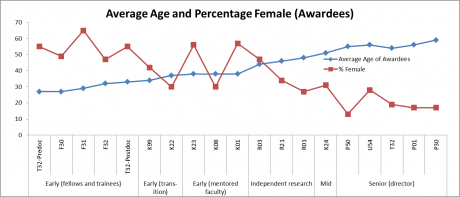Participation of Women in NIH Extramural Programs
Results of a study of sex differences in application, success, and funding rates
This paper presents two studies.The first, a cross-sectional analysis from fiscal year 2008 data, compared women’s and men’s grant application, success, and funding rates for 17 award programs (plus T32 trainees) that represent a typical “career ladder.” As shown in the figure below, which summarizes data shown in the report, the proportion of women applicants compared to men generally decreased at more advanced career stages.Similar findings appeared in a 2007 National Academies report.
The report shows small differences in the success rates or funding rates between women and men for most research programs. Looking specifically at the R01 program, the sexes had equal success rates (23%); however, women had small and what appear to be persistently lower funding rates than men (26% vs. 28%), presumably because men submit more applications per person than women. When we looked separately at new (type 1) applications, the sexes had nearly equal success and funding rates but there were differences with renewal (type 2) applications where men had higher funding rates. Another bright spot is that women and men awardees both received the same percentage of requested direct costs (87.5%) and women actually received larger awards than men.
The second part of the paper goes on to show that men were more likely to have more than one concurrent R01 awards than women. But, looking at all principal investigators with two, three, or four concurrent awards, the study shows that women attain these milestones when they are younger than men. Honing in on factors that may explain the differences between male and female applicants, the paper shows that proportionately more women proposed human subjects research than men (~50% vs. ~30%), and they were equally successful on those applications. However, it was noted that many of these projects are less likely to be submitted for renewal. Also, women were less successful than men on applications that did not involve human subjects.
Read the full Academic Medicine article.




